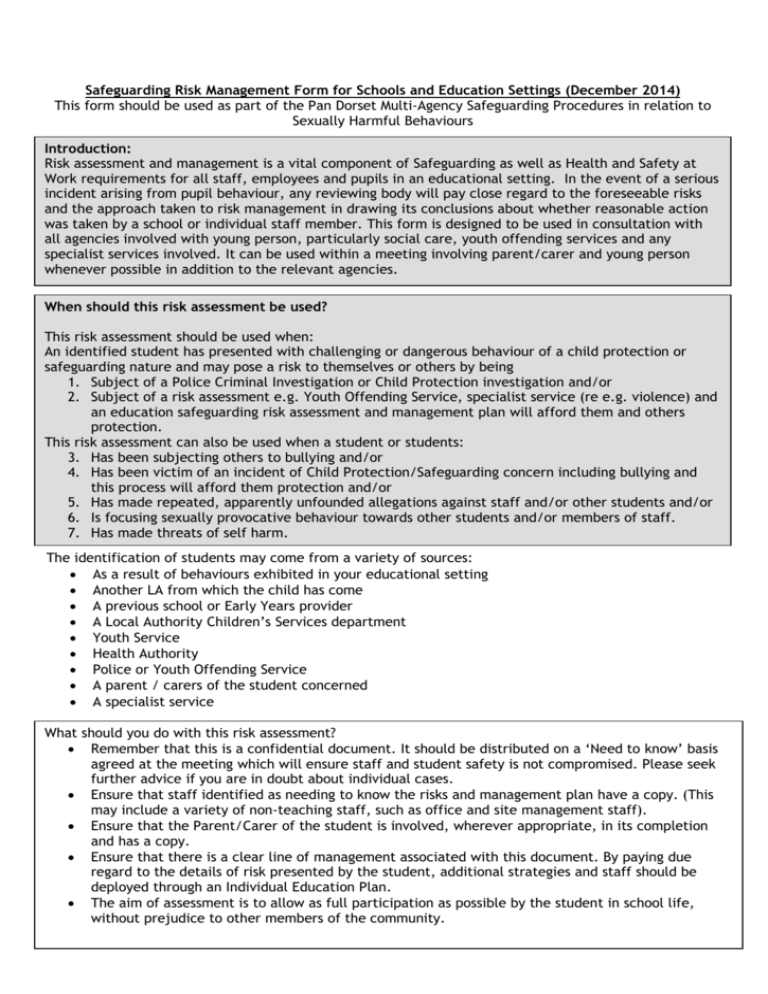Risk Assessment Child Protection/Safeguarding Form
advertisement

Safeguarding Risk Management Form for Schools and Education Settings (December 2014) This form should be used as part of the Pan Dorset Multi-Agency Safeguarding Procedures in relation to Sexually Harmful Behaviours Introduction: Risk assessment and management is a vital component of Safeguarding as well as Health and Safety at Work requirements for all staff, employees and pupils in an educational setting. In the event of a serious incident arising from pupil behaviour, any reviewing body will pay close regard to the foreseeable risks and the approach taken to risk management in drawing its conclusions about whether reasonable action was taken by a school or individual staff member. This form is designed to be used in consultation with all agencies involved with young person, particularly social care, youth offending services and any specialist services involved. It can be used within a meeting involving parent/carer and young person whenever possible in addition to the relevant agencies. When should this risk assessment be used? This risk assessment should be used when: An identified student has presented with challenging or dangerous behaviour of a child protection or safeguarding nature and may pose a risk to themselves or others by being 1. Subject of a Police Criminal Investigation or Child Protection investigation and/or 2. Subject of a risk assessment e.g. Youth Offending Service, specialist service (re e.g. violence) and an education safeguarding risk assessment and management plan will afford them and others protection. This risk assessment can also be used when a student or students: 3. Has been subjecting others to bullying and/or 4. Has been victim of an incident of Child Protection/Safeguarding concern including bullying and this process will afford them protection and/or 5. Has made repeated, apparently unfounded allegations against staff and/or other students and/or 6. Is focusing sexually provocative behaviour towards other students and/or members of staff. 7. Has made threats of self harm. The identification of students may come from a variety of sources: As a result of behaviours exhibited in your educational setting Another LA from which the child has come A previous school or Early Years provider A Local Authority Children’s Services department Youth Service Health Authority Police or Youth Offending Service A parent / carers of the student concerned A specialist service What should you do with this risk assessment? Remember that this is a confidential document. It should be distributed on a ‘Need to know’ basis agreed at the meeting which will ensure staff and student safety is not compromised. Please seek further advice if you are in doubt about individual cases. Ensure that staff identified as needing to know the risks and management plan have a copy. (This may include a variety of non-teaching staff, such as office and site management staff). Ensure that the Parent/Carer of the student is involved, wherever appropriate, in its completion and has a copy. Ensure that there is a clear line of management associated with this document. By paying due regard to the details of risk presented by the student, additional strategies and staff should be deployed through an Individual Education Plan. The aim of assessment is to allow as full participation as possible by the student in school life, without prejudice to other members of the community. CONFIDENTIAL – Risk School/Education Management Child Protection/Safeguarding Form Name of School/Educational Establishment : ……………………………………………………………... Name of Student: ………………………………………………………………………………………………. DoB: ……………………. Age: …………………..Year: ………………………. Completing or assisting with the assessment: Name(s) of persons : Designation: ……………………………………………… …………………………………………………………. ……………………………………………… …………………………………………………………. …………………………………………….. …………………………………………………………. ……………………………………………. …………………………………………………………. Specify any SEN or issues of race, culture or diversity: Date Completed: ……………… Point of Assessment: Prior to admission On admission At annual review/planning meeting Following one/series of critical incidents Details of any other agencies involved (Please tick) Incident: Brief summary of concerns – if relating to other young people care must be taken re confidentiality: Case co-ordinator within education setting (if appropriate) Name and designation: ………………………………………………………………... ………………………………………………………………… Date: ……………. Lead professional or allocated social worker: ……………………………………… Date: ……………. Decision re. Parent/Students Involvement - if not involved please specify why: Agreed Action Points: Parent/Carer’s Name: …………………………………………………………………….. Signature: …………………………………………………………………………… Date: …………………. Pupil’s Name: ………………………………………………………………………. Signature: …………………………………………………………………………… Date: ………………… Social Care/Education Representative Signature: ……………………………………………………………. Date: ……………. (To complete this sheet please refer to the Guidance notes in the appendix) Types of Behaviour Causing Concern (Please select those applicable and known to have occurred and give examples – you may wish to change the types of behaviour to more accurately reflect the behaviour of the student) Self Harm Bullying – Doing it Bullying – subject of it Swearing/ Abusive Sexually inappropriate behaviour Grooming behaviours e.g. befriending vulnerable pupils, being overly complaint to ‘put staff on guard’ Sexually provocative behaviour Inappropriate behaviour Violent/aggressive behaviour Substance/alcohol misuse Racial/Gender/Religious/Learning Disability discrimination Absconding/absenting Damage to property Offending behaviour (e.g. stealing) Carrying/using weaponry Reckless disregard for personal safety (e.g. running across busy roads) Other (Please specify) Frequency H = hourly D = daily W = weekly O= occasionally M = monthly Intentionality D = deliberate A = accidental Or Incidental I = involuntary Risk Hazar d (H) 1-4 Proba bility (P) 1-4 LEVEL OF RISK (HP) 1-16 (add level descriptor) TRIGGER POINTS Educational difficulties Details: Issues with certain staff Details: Issues with certain peers/groups Details: Control/authority issues Details: Gender/racial issues Details: Frustration with self Details: Additional Details: The accompanying Behaviour Management Plan should explain the circumstances where adult intervention will be used (because the risks associated with it are judged to be less than if no intervention was used). If it does not, please indicate here: LOCATIONS OF VULNERABILITY Tick all that apply: Classroom/teaching areas In corridors/between lessons In school toilets Practical lessons P.E. Unstructured times (Playtimes) At mealtimes/dinner hall Social time before/after school School transport (taxi) Minibus/School trips Behaviour when medication not taken At home In community List any Orders Additional details: (include any environmental conditions such as large groups and noise levels) ADDITIONAL CONTROL MEASURES REQUIRED TO REDUCE RISK Additional staff experienced in issues of Emotional Behaviour and Social difficulties. (*) Specific timetable modification or curriculum disapplication. (*) Specific/named senior staff as persons called for/student sent to in emerging crisis. (*) Behaviour Management Plan (BMP) or existing Individual Education Plan/Pastoral Support Plan. (*) BMP with Positive Handling Strategies (Restrictive Physical Intervention) (*) Specific equipment/resources made available to student or staff. Identified location(s) for calming down or ‘Timeout’. Additional staff to support specific curriculum issues. Staff not to be alone with student. Supervised during unstructured times/playtimes/school arrival & departure specify level e.g. 1:1 at all times. Parental support on hand/attendance in school. Local Authority Social Care Dept. providing support. Local Police informed. Modification or restriction of school visits or work placements Increase of personal tutorials. Change of tutor group/subject set groups. Escorts in school transport/taxis Additional training required for staff (*) Please ensure that all necessary information is kept with this document, and available to relevant staff and parent/carer. APPENDIX GUIDANCE NOTES ON SOME CHRACTERISTICS ASSOCIATED WITH CATEGORIES Matrix: Hazard Probability =n Level of Risk Seek views of e.g. Headteacher, Service manager, Designated Child Protection Officer HAZARD Level of Harm Presented PROBABILITY LEVEL OF RISK (Hazard Probability) LOW = 1 Causes occasional and minor disruption Little or no additional staff deployed. Causes some offence with some staff, e.g. swears as walking away/mutters under breath No harm to others. LOW = 1 Could happen in occasional circumstances e.g. when confronted insensitively or by adults not known to the pupil. Taking part in a highly structures activity Triggered by specific well known factors that can be planned for. LOW: 1 - 4 Acceptable range of behaviour given age, maturity, emotional difficulty and personal circumstances. Occasional incidents of non-compliance/challenge associated with mood swings. Potential health and safety risk to other staff and pupils. MODERATE = 2 Occasional harm to others/ self or damage to property. Distress caused is more widespread. Offends with language, makes sexualised comments or actions, use of subtle coercion or lower level grooming behaviours, but still biddable. Extra resources/staff can often stabilise situation MODERATE = 2 May happen with some regularity with known triggers. Documented patterns of antecedent and behaviours emerging. Will respond to staff at higher levels of authority or key worker and is able to discuss issues. MODERATE: 5 - 8 Commonplace incidents of non-compliance/challenge including dangerous behaviour associated with impulsiveness, a lack of anticipation and acceptance of consequentiality. Absenting or absconding. Ignoring adult advice and guidance. Student will usually respond to Positive Handling Strategies. Behaviour goes into remission quickly. Regular incidents of non-compliance/challenge including aggressive confrontations with others. Will avoid adult supervision if possible. Reduce hazards where possible. Pupil considered for appropriateness of certain lessons/locations. SUBSTANTIAL = 3 Frequent damage with necessary costs of replacement. Personal safety of student/others is compromised. Needing supervision and special arrangements. Implications for people/property beyond school grounds. Offensive and disruptive to a wide section of the community. Use of coercion or threat More obvious pattern of grooming behaviours An allegation by other young person or staff member. SUBSTANTIAL = 3 Very likely to happen) Child does not show acceptance of authority hierarchy. Does not acknowledge that their behaviour is unacceptable Pupil may have become disaffected and disenfranchised. Most adults are unable to affect a positive intervention. Ongoing self harm SUBSTANTIAL: 9 - 12 Numerous incidents of non-compliance and severe challenge including violence and aggression associated with a loss of emotional control. Regular absenting from class necessitating monitoring. NIB absence may enable the young person to plan or pursue unacceptable abusive behaviour away from adult supervision. Undermining of adult authority to present challenge to the security of the structured environment, sustained over time. Will react negatively to Positive Handling Strategies but remission is forthcoming. Careful staff allocation needed to reduce likelihood and effects of behaviour. Work routines of student and peers needs careful planning. Any allegation must be reported to Social Care. HIGH = 4 Significant injury to others/self. Traumatic effect on peers/adults. Damage levels and replacement costs in excess of £250.00 Abuse of others Targeting young people for exploitation Abuse by self or others Evidence that the young person successfully is, or has, groomed the adults and young person. (NIB can be by use of text or internet. HIGH = 4 (Established Pattern of previous or ongoing occurrence Expert management by groups of staff usually fail to remediate the situation. Pupil self control is virtually non-existent. Volatile and over-sensitised to school environment such that triggers are frequent and globally located around the establishment. Threats of suicide HIGH: 16 Numerous incidents of non-compliance and severe challenge including dangerous, violent and aggressive behaviour. Characterised by bullying and/or assault with premeditation. Undermining adult authority to the detriment of the security of the structures environment and the safety and welfare of other students/adults. Reacts badly to RPI strategies. Police need to be notified frequently or parental attendance as soon as possible. Immediate continuing action needed. Specialist plans being carried out by designated staff on a daily basis. Further advice needed. Outside support agencies available at short notice. Referrals to the GP and social care must be made for any threat of suicide. The Maple Service can be contacted for urgent assessment. Referrals to social care must be made for any allegation of abuse. The discussion with Social Care will agree action including when and whether the parent/carer can be told







